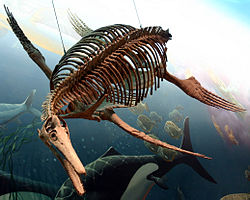Dolichorhynchops
|
Dolichorhynchops Temporal range: Late Cretaceous, 93.5–70.6 Ma |
|
|---|---|
 |
|
| D. osborni, National Museum of Natural History, Washington D. C. | |
| Scientific classification | |
| Kingdom: | Animalia |
| Phylum: | Chordata |
| Class: | Reptilia |
| Superorder: | †Sauropterygia |
| Order: | †Plesiosauria |
| Family: | †Polycotylidae |
| Genus: |
†Dolichorhynchops Williston, 1902 |
| Species | |
Dolichorhynchops is an extinct genus of polycotylid plesiosaur from the Late Cretaceous (early Turonian to late Campanian stage) of North America, containing three species, D. osborni, D. herschelensis and D. tropicensis.Dolichorhynchops was an oceangoing prehistoric reptile. Its Greek generic name means "long-nosed face".
The holotype specimen of Dolichorhynchops osborni was discovered in the upper Smoky Hill Chalk Logan County, Kansas, by George F. Sternberg, as a teenager, in around 1900. The remains were collected by him and his father, Charles H. Sternberg, and then sold to the University of Kansas (Lawrence, Kansas). KUVP 1300 was prepared and mounted by H.T. Martin under the supervision of Dr. Samuel Wendell Williston, who described and named it in 1902. A more detailed description and photographs were provided by Williston 1903). The specimen has been on display in the KU Museum of Natural History since that time.
In 1918, Charles H. Sternberg found a large mosasaur, Tylosaurus, with the remains of a plesiosaur in its stomach. The mosasaur specimen is currently mounted in the United States National Museum (Smithsonian) and the plesiosaur remains are stored in the collections. Although these important specimens were briefly reported by Sternberg 1922, the information was lost to science until 2001. This specimen was rediscovered and described by Everhart 2004a. It is the basis for the story line in the 2007 National Geographic IMAX documentary Sea Monsters: A Prehistoric Adventure, and a book by the same name Everhart 2007.
...
Wikipedia
